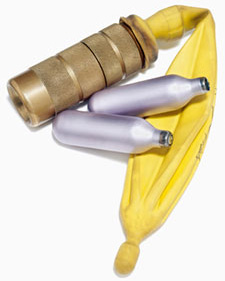Signs and Symptoms of Inhalant Abuse

Inhalant abuse can be one of the most obvious types of abuse. Inhalant abusers may have paint on their faces, may smell of solvents, may leave behind bags impregnated with gasses, solvents or paint, and may deposit piles of rags saturated with paint thinner, degreaser or gasoline. When a person is a confirmed, chronic user, they may leave behind piles of empty compressed air cans or nitrous oxide canisters. Evidence of inhalant abuse may be very hard to hide for the frequent abuser. If a young person is just experimenting with inhalants, detection could be much harder.
There is such a long list of substances that can be inhaled to produce intoxication, it would be very difficult to look all of them up. The list includes markers, nail polish remover, hair spray, fabric protectors and dry cleaning fluid. Even whipped cream canisters can be used, along with some types of glue.
Signs and Symptoms of Inhalants
A person who has been abusing inhalants will have a drunken appearance, his speech will be slurred and he will be disoriented. He may get nauseated and will not be interested in eating. Pupils will be widely dilated.
In fact, in situations of hopeless poverty, many children seek out inhalants to suppress their appetites so they don’t mind not having food. For example, in Nepal, thousands of street children abuse a cheap glue called dendrite.
A person high on inhalants is likely to suffer exhaustion and an inability to focus. Less obvious signs of inhalant abuse include damage to blood, kidneys, liver, heart and bone marrow. One’s judgment is impaired and inhibitions are lowered after heavy use. This may lead a person to engage in irresponsible or dangerous activity.
The Most Dangerous Symptoms of Inhalants
The use of inhalants can be fatal. In the lungs of a person abusing inhalants, the oxygen is being replaced by a gas that is at best useless–and at worst, deadly to the body. Abusers can suffer an irregular heartbeat that results in death or cardiac arrest. A person can even suffocate as a result of this habit, resulting in unconsciousness, coma or death.
Inhalant abuse results in a tolerance to the drug, meaning that more of the substance is needed to get the same response. This means that the risk of abuse is going to become more serious. Permanent brain damage can result. A person suffering damage from inhalants can experience mood swings, shakiness and even seizures.

When a person abuses nitrites, such as inhaling the gasses in whipped cream containers, the signs can include severe headaches, blindness or glaucoma.
Real-Life Signs of Inhalant Addiction
One video from a British television show featured a woman addicted to butane gas for twenty years. She would inhale the gas as much as twice a minute, every day of her life, and almost around the clock since she only slept about an hour a night. Her consumption averaged twelve cans of butane a day.
Another video depicts a series of mug shots that show the deterioration of a man who was arrested dozens of times over a fourteen year period, his lower face covered with spray paint in nearly every instance.
The cable television show Intervention featured a young woman who inhaled the contents of ten computer-cleaner compressed air cans each day. She lived an existence completely removed from reality. According to this show, one-third of all inhalant deaths come from first-time uses.
Rehab Is Needed If a Person Can’t Quit
A person who can’t quit using these substances needs drug rehab just as much as a cocaine addict or alcoholic. Some of these substances are physically addicting, and all are psychologically addicting.
Inhalant addicts can find the help they need at Narconon drug and alcohol rehabilitation centers around the world. This is a residential program which enables people to focus on repairing the damage they have suffered.
A thorough detoxification followed by counseling and life skills training enable a person in a drug program to see things in a whole new light so they can live an enjoyable, productive life again. This is the way the Narconon drug and alcohol rehabilitation program works.
Find out how this program can help you or someone you care about get back on a sober path in life.
See also the Effects of Inhalant Abuse
Resources:

